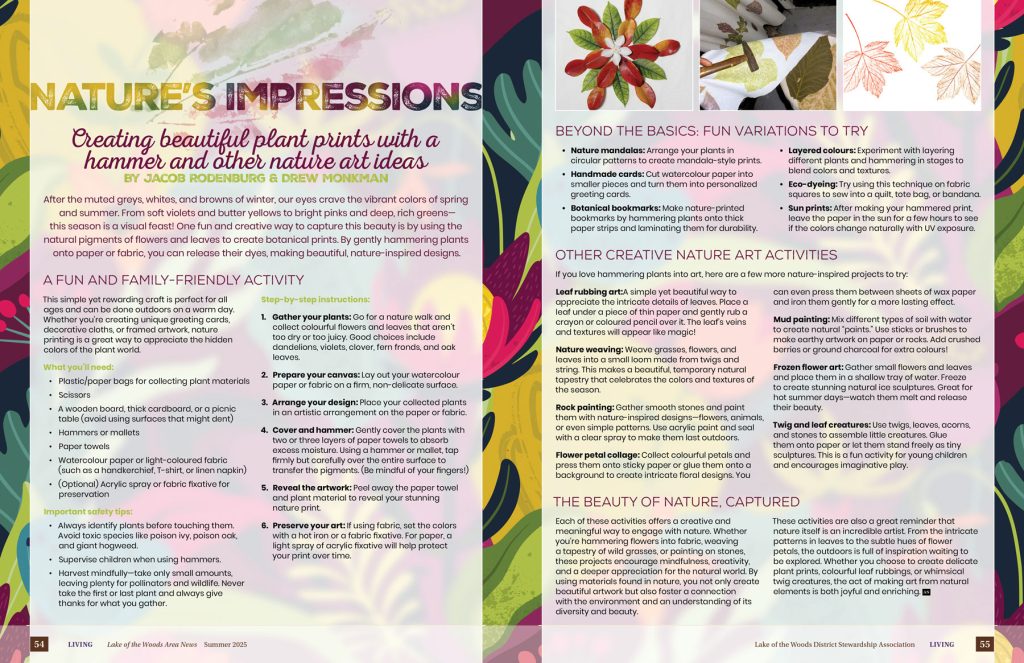Originally published in Lake of the Woods Area News, Volume 55, Number 3, Summer 2025
After the muted greys, whites, and browns of winter, our eyes crave the vibrant colors of spring and summer. From soft violets and butter yellows to bright pinks and deep, rich greens—this season is a visual feast! One fun and creative way to capture this beauty is by using the natural pigments of flowers and leaves to create botanical prints. By gently hammering plants onto paper or fabric, you can release their dyes, making beautiful, nature-inspired designs.
A fun and family-friendly activity
This simple yet rewarding craft is perfect for all ages and can be done outdoors on a warm day. Whether you’re creating unique greeting cards, decorative cloths, or framed artwork, nature printing is a great way to appreciate the hidden colors of the plant world.
What you’ll need:
- Plastic/paper bags for collecting plant materials
- Scissors
- A wooden board, thick cardboard, or a picnic table (avoid using surfaces that might dent)
- Hammers or mallets
- Paper towels
- Watercolour paper or light-coloured fabric (such as a handkerchief, T-shirt, or linen napkin)
- (Optional) Acrylic spray or fabric fixative for preservation
Important safety tips:
- Always identify plants before touching them. Avoid toxic species like poison ivy, poison oak, and giant hogweed.
- Supervise children when using hammers.
- Harvest mindfully—take only small amounts, leaving plenty for pollinators and wildlife. Never take the first or last plant and always give thanks for what you gather.
Step-by-step instructions:
- Gather your plants: Go for a nature walk and collect colourful flowers and leaves that aren’t too dry or too juicy. Good choices include dandelions, violets, clover, fern fronds, and oak leaves.
- Prepare your canvas: Lay out your watercolour paper or fabric on a firm, non-delicate surface.
- Arrange your design: Place your collected plants in an artistic arrangement on the paper or fabric.
- Cover and hammer: Gently cover the plants with two or three layers of paper towels to absorb excess moisture. Using a hammer or mallet, tap firmly but carefully over the entire surface to transfer the pigments. (Be mindful of your fingers!)
- Reveal the artwork: Peel away the paper towel and plant material to reveal your stunning nature print.
- Preserve your art: If using fabric, set the colors with a hot iron or a fabric fixative. For paper, a light spray of acrylic fixative will help protect your print over time.
Beyond the basics: Fun variations to try
- Nature mandalas: Arrange your plants in circular patterns to create mandala-style prints.
- Handmade cards: Cut watercolour paper into smaller pieces and turn them into personalized greeting cards.
- Botanical bookmarks: Make nature-printed bookmarks by hammering plants onto thick paper strips and laminating them for durability.
- Layered colours: Experiment with layering different plants and hammering in stages to blend colors and textures.
- Eco-dyeing: Try using this technique on fabric squares to sew into a quilt, tote bag, or bandana.
- Sun prints: After making your hammered print, leave the paper in the sun for a few hours to see if the colors change naturally with UV exposure.
Other creative nature art activities
If you love hammering plants into art, here are a few more nature-inspired projects to try:
- Leaf rubbing art:A simple yet beautiful way to appreciate the intricate details of leaves. Place a leaf under a piece of thin paper and gently rub a crayon or coloured pencil over it. The leaf’s veins and textures will appear like magic!
- Nature weaving: Weave grasses, flowers, and leaves into a small loom made from twigs and string. This makes a beautiful, temporary natural tapestry that celebrates the colors and textures of the season.
- Rock painting: Gather smooth stones and paint them with nature-inspired designs—flowers, animals, or even simple patterns. Use acrylic paint and seal with a clear spray to make them last outdoors.
- Flower petal collage: Collect colourful petals and press them onto sticky paper or glue them onto a background to create intricate floral designs. You can even press them between sheets of wax paper and iron them gently for a more lasting effect.
- Mud painting: Mix different types of soil with water to create natural “paints.” Use sticks or brushes to make earthy artwork on paper or rocks. Add crushed berries or ground charcoal for extra colours!
- Frozen flower art: Gather small flowers and leaves and place them in a shallow tray of water. Freeze to create stunning natural ice sculptures. Great for hot summer days—watch them melt and release their beauty.
- Twig and leaf creatures: Use twigs, leaves, acorns, and stones to assemble little creatures. Glue them onto paper or let them stand freely as tiny sculptures. This is a fun activity for young children and encourages imaginative play.
The beauty of nature, captured
Each of these activities offers a creative and meaningful way to engage with nature. Whether you’re hammering flowers into fabric, weaving a tapestry of wild grasses, or painting on stones, these projects encourage mindfulness, creativity, and a deeper appreciation for the natural world. By using materials found in nature, you not only create beautiful artwork but also foster a connection with the environment and an understanding of its diversity and beauty.
These activities are also a great reminder that nature itself is an incredible artist. From the intricate patterns in leaves to the subtle hues of flower petals, the outdoors is full of inspiration waiting to be explored. Whether you choose to create delicate plant prints, colourful leaf rubbings, or whimsical twig creatures, the act of making art from natural elements is both joyful and enriching.

